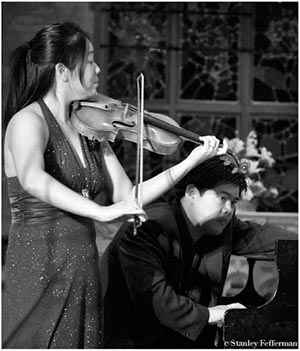 |
Duo Diorama
presented by New Music Concerts |
|
| January 17, 2009 • The Music Gallery • Toronto |
|
|
|
|
|
|
| Report & photo by Stanley Fefferman |
| Duo Diorama is the husband and wife team of pianist Winston Choi and violinist Minghaun Xu. While they both have active, worldwide careers as concert soloists and as teachers at American Universities, as a Duo they have become a leading proponent of music of living composers. In the last few years, they have commissioned and premiered over 20 works. The program of last night’s very full program included four newly commissioned works, with three of the composers present: John Austin (U.S.A 1934), Brian Current (Canada, 1972), and John Melby (U.S.A.) who also ‘played’ the electronics of his piece. |
| John Melby mentioned, in an illuminating pre-concert group interview (that is one of the specialties of New Music Concerts), that he’d like it if people listened to his Concerto for violin, piano and computer (2008) as if it were Brahms. Melby’s Concerto was fun to listen to because it is a triple concerto and more. The violin and the piano have their parts and their cadenzas. The orchestral component is supplied by the computer’s electronically generated and managed sounds that come from another dimension that generates yet another sonic dimension as they windshield-wiper across the room between the left and right stereo speakers. The orchestra participates with the soloists and also has many interludes of its own, filling the room with weird organ-synth outpourings, reverbs, feedbacks, hollow spacey rings dings gongs and a few high pitches that made the stereocilia of the inner ear dance frantically. And, indeed, amid the fiendishly difficult gestures of violin and piano one could at times hear Brahmsian textures both soothing and dramatic. |
|

Minghaun Xu & Winston Choi |
|
| Winston Choi played Affulgat sol omnibus animalibus dei (2007) written for him by Brian Current. Choi had mentioned in the pre-concert interview that Current’s writing challenged him to work out new fingerings. The music for each hand is often very different, with a stream of arpeggios rippling out of his left hand while the right hand taps out a thematic motive. There are passages built on repeated phrases that move cross-handed from left to right and jazzy bits where the right handles the fluid streamings and the left works out repeated figures. The effect of the contrasting textures and moods of energy and calm is a bit like the play of light over a bed of shale, or traffic flowing over macadam.
John Austin’s Three Translations for violin and piano (2008) is based on three classical Chinese poems in which “nothing is connected,” and where “a world of emotion is expressed through the objective world.” There are Chinese tones singing in the strings and the crystalline fall of notes from the keyboard or faint ripples of wind as Mr. Choi reaches in and strums the strings. There are falling cadences, romantic and sad, forceful scrubbing of violin strings, soothing piano meditations, and silent rests that convey peace.
Bright Sheng’s The Stream Flows for solo violin (1990) showcased the gorgeous, deep, woody tones of Ms. Xu’s Nicolas Gagliano that she plays with untiring precision, strength and clarity. The piece offers a lot of variety: raucous fiddling, eerie whistling, rough staccato pizzicato, sleepy lullabies, passages of sheer beauty, and a kind of playfulness that radiated from Ms. Xu’s face. Her virtuosity impresses.
Elliott Carter’s Duo for violin and piano (1974), and Marcos Balter’s RE: (No Subject) for violin and piano (2008) filled the bill.
|
|
|
|
|
|
|
| Stanley Fefferman is a writer/photographer on the Toronto music scene and elsewhere. His work appears online at www.showtimemagazine.ca and here at The LMR. |
|
|


